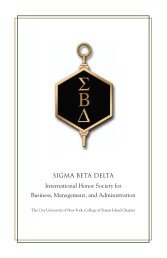CSI in the News - CSI Today
CSI in the News - CSI Today
CSI in the News - CSI Today
You also want an ePaper? Increase the reach of your titles
YUMPU automatically turns print PDFs into web optimized ePapers that Google loves.
March 21, 2011 Monday 15 AdarII 5771 9:22 ISTGod of <strong>the</strong> Earth: When eat<strong>in</strong>g meat was asacrificeBy RICHARD H SCHWARTZ18/03/2011It’s time for <strong>the</strong> Jewish community to reconsider its diet, as this week's Torahportion deals with meal-offer<strong>in</strong>gs <strong>in</strong> <strong>the</strong> Mishkan.Photo by: CourtesyThis week’s Torah portion, Tzav, gives <strong>in</strong>structions on meat sacrifice, “And that which is left <strong>the</strong>reof [from <strong>the</strong>meal-offer<strong>in</strong>g] shall Aaron and his sons eat; it shall be eaten without leaven <strong>in</strong> a holy place; <strong>in</strong> <strong>the</strong> tent ofmeet<strong>in</strong>g <strong>the</strong>y shall eat it... It is most holy as <strong>the</strong> s<strong>in</strong>-offer<strong>in</strong>g and <strong>the</strong> guilt-offer<strong>in</strong>g.”When <strong>the</strong> Jewish people were <strong>in</strong> <strong>the</strong> wilderness before <strong>the</strong>y entered <strong>the</strong> land of Israel, <strong>the</strong> consumption ofmeat was associated with hol<strong>in</strong>ess. Every piece of meat consumed came from an animal sacrificed <strong>in</strong> <strong>the</strong>Mishkan (Sanctuary), an act meant to br<strong>in</strong>g <strong>the</strong> worshiper closer to G-d. The word korban (sacrifice) is relatedto lekarev, to come close. Through <strong>the</strong> sacrifice, worshipers felt that <strong>the</strong>y were giv<strong>in</strong>g <strong>the</strong>mselves vicariouslyto G-d.If a sacrificial animal was slaughtered <strong>in</strong> a place o<strong>the</strong>r than <strong>the</strong> altar of <strong>the</strong> Sanctuary, it was deemed unlawful,and <strong>the</strong> perpetrator was deserv<strong>in</strong>g of Div<strong>in</strong>e punishment.In <strong>the</strong> times of <strong>the</strong> Mishkan <strong>the</strong> consumption of meat was not someth<strong>in</strong>g taken for granted, as it generally istoday. Each sacrifice had a def<strong>in</strong>ite purpose: to offer thanksgiv<strong>in</strong>g, to atone for a s<strong>in</strong>, to commemorate a holyday (such as <strong>the</strong> Korban Pesach, or Paschal Lamb), or to make one feel closer to G-d. Those offer<strong>in</strong>g asacrifice felt that <strong>the</strong>y were giv<strong>in</strong>g up someth<strong>in</strong>g from <strong>the</strong>ir prized possessions. People owned animals assources of labor or food, as well as a form of capital; hence slaughter<strong>in</strong>g <strong>the</strong>m <strong>in</strong> connection with <strong>the</strong> Templerites was a sacrifice of a precious source of <strong>in</strong>come and food. The animal was not considered just a distantcommodity as is generally <strong>the</strong> case <strong>in</strong> today's world of corporate agriculture; ra<strong>the</strong>r, it was a creature that <strong>the</strong>owner raised and saw on a daily basis, and whose needs were a matter of personal responsibility and evenconcern. S<strong>in</strong>ce a mo<strong>the</strong>r animal and its offspr<strong>in</strong>g could not be slaughtered on <strong>the</strong> same day those who offeredsacrifices needed to be aware of familial relationships among animals to be offered as sacrifices.Rabbi Shlomo Risk<strong>in</strong>, Chief Rabbi of Efrat, po<strong>in</strong>ts out that worshipers were very much <strong>in</strong>volved <strong>in</strong> <strong>the</strong>sacrificial process. For s<strong>in</strong> offer<strong>in</strong>gs, <strong>the</strong>y were required to lean <strong>the</strong>ir hands on <strong>the</strong> animal, and make aconfession prior to <strong>the</strong> act of slaughter. Rabbi Risk<strong>in</strong> expla<strong>in</strong>s that <strong>the</strong> emotional result on <strong>the</strong> one whobrought <strong>the</strong> sacrifice and watched it be<strong>in</strong>g killed was to contemplate that because of <strong>the</strong>ir s<strong>in</strong> <strong>the</strong>y deserved tobe <strong>the</strong> ones on <strong>the</strong> altar. Thus <strong>the</strong>y would experience feel<strong>in</strong>gs of teshuvah (repentance) and becometransformed, worthy of a renewed lease on life.The relatively small number of sacrifices performed daily meant that attention was given to <strong>the</strong> death of eachanimal. Sanctity was related to physical wholeness and perfection. The Kohanim (Priests) had to be free ofbodily imperfections, and <strong>the</strong> animals to be sacrificed had to be free of blemishes. Hence, <strong>the</strong> notion ofhol<strong>in</strong>ess was given physical expression <strong>in</strong> <strong>the</strong> concept of hol<strong>in</strong>ess of body and limb.Far different is <strong>the</strong> eat<strong>in</strong>g of meat today. Ra<strong>the</strong>r than an <strong>in</strong>frequent act, many people <strong>in</strong> modern societiesPage 41 of 179
















